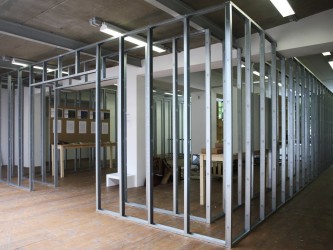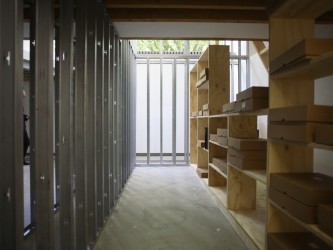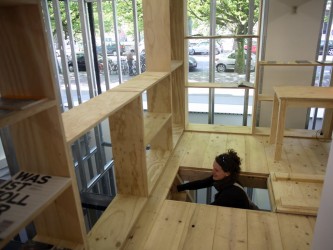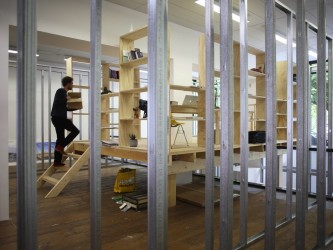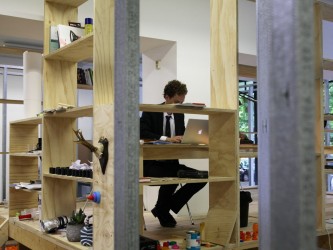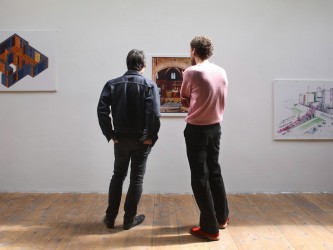Retrospective exhibition on the oeuvre of Observatorium. A two storey house with a study and an archive space was built for Bram Esser, who worked in the gallery for six weeks, studying and reporting on his tour of the sculptures and locations where Observatorium has worked.
ANTONELLO
An "Antonello" in Observatorium's parlance is an inhabited sculpture. It is an object into which the person has withdrawn to perform a self-imposed task, while remaining observable and possibly open to interruptions. The thin line between public and private is inherent to the nature of the encounter of observer and spectator.
Invitation
"In the opinion of myself and my colleagues here at Stroom, Observatorium has in the course of time built up an impressive, important oeuvre. We would like to devote some attention to it in the form of a exhibition, perhaps a retrospective one. The objectives of Stroom – taking an interdisciplinary approach to the urban surroundings, visual double entendre, room within these parameters for the visionary – may well be unusual but they are rooted in social and cultural developments. Artists, organizations and groups play a major part in this. We regard some of these as 'absolute references', to put it a little bombastically." Arno van Roosmalen, Director Stroom The Hague.
The invitation to present a review of Observatorium's work coincided with an invitation by Peter de Winter of 010 Publishers to publish an account of our work. The latter invitation was purely verbal and ran roughly as follows: "I'm curious about where your work comes from, and I'd like to publish a book of your own reflections on and accounts of Observatorium's origins and intentions. This insider's description can make a meaningful contribution to the discourse on the design and use of public space. And it will show how close your sculptures are to architecture."
Our responses were as follows: "We wish to make an exhibition that not only shows what we have done but also generates something new. And we'd like to write a book that not only describes but concludes." We thought hard about the book and tried to apply lessons from previous experiences. Perhaps we learned something in the process too. For the exhibition, our intention was to allow a certain person – our "narrator" – to become acquainted with our work, and then, we hoped, to use the exhibition as an occasion to display, present and supplement his or her reflections. It is not really an exhibition but a study room. It is not a retrospective review but a person trying, in full public view, to shed light on something; just like a book.
To find a suitable narrator, we expressed the concept of the exhibition in the form of a job vacancy. The job description of the desired narrator of our stories was as follows. "Observatorium is holding a retrospective exhibition of the period 1997–2009 in the gallery of Stroom, The Hague. The exhibition is a story, related by a person residing in the exhibition space. The story will be formulated neither by Stroom nor Observatorium, but by the narrator. The narrator will travel to visit places and people where Observatorium has been, and pose questions about the nature of Observatorium's ideals and actions.
He formulates, imagines and asks, 'Will this place benefit from a sculpture? What do the neighbours say about it? What world view does it disclose? How will it stand up to the test of time? Who owns it and who will care for it? What is the future of the sculpture or the idea? Can we laugh at it?'
The narrator may invite others to contribute observations, drawings, photos or stories, and incorporate these into his own story. The collected reflections and the presence of the narrator form the core of the exhibition. The story will be narrated as far as possible in the gallery itself. The narrator's travels and journals, the images and any souvenirs collected all form elements of the narrative. The narrator may take his or her time, and the spectator is given time.
The painting of St. Jerome in His Study displays all the elements of the show: a platform, bookcases, sculptural objects, texts, animals and a person narrating and reading who symbolizes reflection. In consultation with the observer, Observatorium will build an inhabitable
installation on the ground floor of Stroom. The basement contains Observatorium's archives, some bookcases and many boxes, and there will be some documents pinned to the wall.
The qualities we seek are independence, open-mindedness, storytelling ability, a critical eye, editorial skills and someone with oceans of time." The journalist and philosopher Bram Esser satisfied these criteria and was free for three months.
-------------------------------
He formulates, imagines and asks, 'Will this place benefit from a sculpture? What do the neighbours say about it? What world view does it disclose? How will it stand up to the test of time? Who owns it and who will care for it? What is the future of the sculpture or the idea? Can we laugh at it?' The narrator may invite others to contribute observations, drawings, photos or stories, and incorporate these into his own story. The collected reflections and the presence of the narrator form the core of the exhibition. The story will be narrated as far as possible in the gallery itself. The narrator's travels and journals, the images and any souvenirs collected all form elements of the narrative. The narrator may take his or her time, and the spectator is given time.
The painting of St. Jerome in His Study displays all the elements of the show: a platform, bookcases, sculptural objects, texts, animals and a person narrating and reading who symbolizes reflection. In consultation with the observer, Observatorium will build an inhabitable installation on the ground floor of Stroom. The basement contains Observatorium's archives, some bookcases and many boxes, and there will be some documents pinned to the wall.
The qualities we seek are independence, open-mindedness, storytelling ability, a critical eye, editorial skills and someone with oceans of time."
The journalist and philosopher Bram Esser satisfied these criteria and was free for three months. The Beauty of Misunderstanding Bram Esser, philosopher/writer, The Hague, 2009 "Would you like to be a scout for us?" The question, posed to him three months ago, sounded at the time like a simple, offhand request. What had to be scouted out, and why, was as yet unspoken. "It's about art in the public space, in the Netherlands and in Germany, but it's crucial that you know as little as possible about the artists.
location: Stroom, The Hague
year:2009
images:
